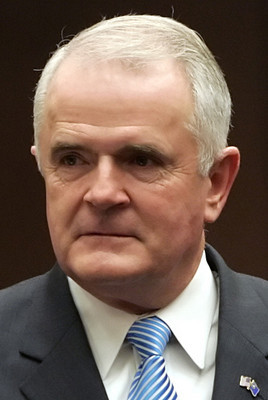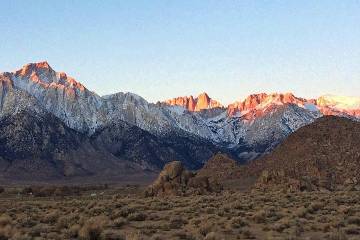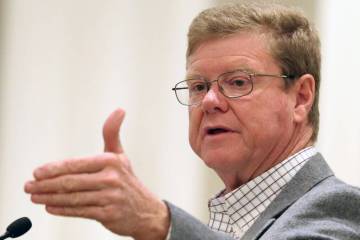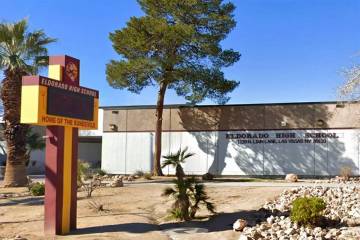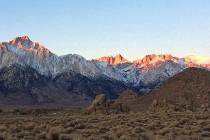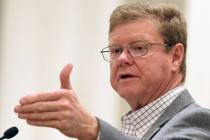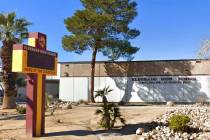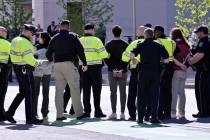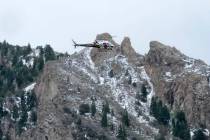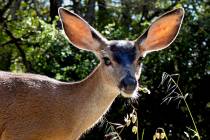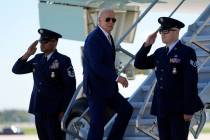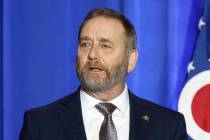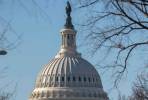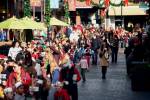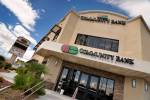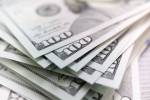State budget woes to continue
CARSON CITY -- Gov. Jim Gibbons and state legislators cannot count on a quick recovery from the severe economic downturn that has left them scampering to find where to cut $898 million from Nevada's two-year budget.
Economists and housing industry experts predict the state's flat economy won't turn around before the last half of 2009 and might not regain its usual robust growth for another three to five years.
That means the state's top elected officials not only face decisions this week on how to make dramatic cuts, they're also likely to go into the legislative session next year with tax revenues no larger than today's.
"Our state is going to be in a world of hurt," said Assemblywoman Sheila Leslie, D-Reno. "That reality is starting to sink in at my level. It is frightening."
Legislators and Gibbons are scheduled to resume discussions today on how to cut an additional $333 million out of the $6.8 billion two-year budget without cutting services or laying off workers.
Another $565 million was cut in January, including a 4.5 percent reduction for state agencies.
The time when politicians could campaign for more full-day kindergarten classes and expansion of state services is over, said Eric Herzik, a political science professor at the University of Nevada, Reno.
"It is not a rosy future," he said. "Remember, just six months ago people were saying Jim Gibbons was making things up when he started talking about budget cuts. Well, nobody is in denial anymore."
Herzik said legislators are going to walk into the 2009 session with no ability to expand services unless they increase taxes at a time "when people in the state are hurting."
Gibbons vowed within hours after the 2007 session ended to veto any bills increasing taxes in 2009.
Democratic leaders such as Assembly Speaker Barbara Buckley won't lead the charge for higher taxes if they have aspirations for the governor's race in 2010, Herzik predicted.
But Buckley said Saturday the only thing she is certain to do at this point is seek re-election to the Assembly, where she'll seek to protect public education and other government services from additional cuts.
"This is the real thing," state Sen. Bob Beers said about the downturn. "It is certain Nevada families are dealing with less, and my concern is we would hurt them further by a misguided reaction to it by raising taxes."
Beers, R-Las Vegas, blames the record $833 million tax increase in 2003 and the move by health care advocates -- and approved by voters -- to prohibit smoking in restaurants and bars in 2006 for exacerbating the current economic crisis.
He said the tax increases and the smoking ban caused some people to cut back on purchases and not eat out as much.
Budget Director Andrew Clinger said a number of cuts being considered include:
•Taking $40 million in general fund revenue set aside for the $245 million expansion of Interstate 15 from the Spaghetti Bowl to Craig Road in Las Vegas. The project still would be built on schedule, but paid for using Transportation Department gasoline tax money.
•Delaying construction of the $90 million Health Sciences Center on university campuses, and possibly postponing the expansion of four state prisons. Those projects still would be designed, but construction would be delayed. The governor wants to save $150 million to $180 million by delaying construction projects.
•Using the $35 million left in the state's rainy day fund and postponing the payment of $36 million set aside to settle a tax case with Southern California Edison, which operated a now closed power plant near Laughlin.
•Requiring state agencies to cut spending in the fiscal year starting July 1 by $52 million, or 3 percent. The agencies affected have not been determined.
Although revenue has fallen far below expectations, Nevada growth has not stopped.
State Demographer Jeff Hardcastle reported Wednesday that the state population growth slowed to a 3.6 percent increase in the year ending June 30.
But the state still added 95,287 residents. And the U.S. Census Bureau announced in December that Nevada was the fastest-growing state for the 20th time in 21 years.
Public school enrollment also has slowed, but is expected to increase by 13,750 students in the 2009-11 budget period.
Nevada now spends $5,100 per student, or more than 35 percent of the state's budget, on public school education.
Legislators are beginning to realize there will be little, if any, additional money to cover this growth and inflation, which averaged 4 percent over the last 12 months.
"It is a problem we will have to deal with," said state Senate Majority Leader Bill Raggio, R-Reno.
Gibbons said last Monday he intends to balance the budget now and again in 2009 without taking more taxes from residents who must pay $5 per gallon for milk and more than $3 per gallon for gasoline.
Raggio, a state senator for 35 years, said the downturn is not that unusual.
"Percentagewise it probably is less than during (Gov. Bob) Miller's administration," he said. "There are 27 other states to my knowledge that have similar problems."
Raggio remembers Miller cutting spending by more than 10 percent during a recession in 1991-92.
The current revenue decline is 8.7 percent.
But the economy quickly recovered after Miller's cuts.
That might not happen this time, said Dennis Smith, president of Home Builders Research in Las Vegas.
"I am not sure yet we have hit bottom," Smith said about the slump in the housing market. "I do not see a return to the heyday (of 2004-06). Loans are harder to get. It will turn around. How long is it going to take? Maybe three years to five years."
Herzik said the difference from the recession in Miller's administration was that state tourism declined largely because of poor economies in California and other states.
"This time it is affecting Nevadans," he said. "The housing slump, the foreclosures have hit Nevada worse than anywhere else. In the past, bad things happened to other people."
State economist Jim Shabi sees some recovery occurring late in 2009, when the City Center hotel-condominum complex in Las Vegas is expected to open and offer 12,000 jobs.
But the tightening of credit standards makes it difficult to acquire loans for both residential and commercial construction, and gaming industry executives might postpone big Southern Nevada projects, he said.
"We really don't have a crystal ball that says when we will recover," Shabi said. "They (lenders) aren't giving away money any more."
The drop in real estate sales has been blamed by Clinger for spawning state government's economic woes.
At briefings, he has explained that when home sales began to decline last year, residents also did not buy as many big ticket items like cars and refrigerators.
That caused sale tax receipts to plunge.
Then, gasoline prices skyrocketed and people didn't have as much discretionary income to spend on eating out and shopping in the local malls.
Keith Schwer, director of the Center for Business and Economic Research at UNLV, is more optimistic than others about a quicker recovery.
He predicts a bump in the economy late this spring when taxpayers receive $600 rebate checks under the federal economic stimulus plan.
"It won't be dramatic, but it will help," Schwer said. "It is hard to see a big recession coming. We aren't falling off the face of the earth. We still have some job growth, and increased job growth will go a long way toward filling up excess housing units."
Herzik noted even cigarette and liquor sales are off during the current downturn.
"What we need is for people to start gambling, drinking and smoking," said Herzik, not entirely in jest.
Contact Capital Bureau Chief Ed Vogel at evogel@reviewjournal.com or 775-687-3901.



